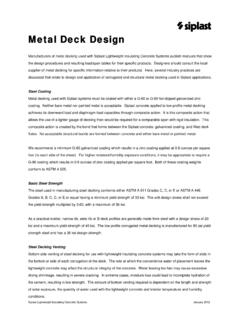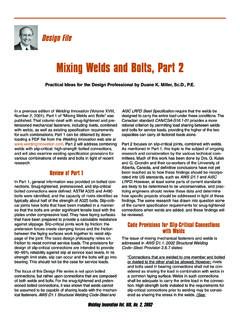Transcription of Siplast Roof Insulation Systems
1 Diaphragm Design Roofing elements have been designed to perform as structural diaphragms for many years in earthquake-prone regions including, Zones 3 & 4 (see Figure 1). The use of the principles of diaphragm design is more recently gaining widespread acceptance in areas subject to high wind load (see Figure 2). These hurricane, tornado, and windstorm-prone areas of the United States are using roof diaphragm design as a cost effective and sound engineering alternative to diagonal bracing, drag struts, and other methods of accommodating such forces. The roof diaphragm is an assembly of joists and panels. The panels are attached to the joists and cause the roof construction to act like the web of an I-beam when subjected to lateral forces.
2 The roof diaphragm braces the walls and allows lateral load transfers from the roof level through walls to the foundation. Several important factors affect the design and performance of diaphragm constructions. Principally, they are the steel deck gauge and section properties related to load/span tables, the method of attaching the steel deck to the joist system, and the diaphragm to wall connection. Design Procedures/Load-Span Tables The specific design procedure for diaphragm construction varies by geographical location in the United States. For example, the California area procedures for earthquake design are governed by the Uniform Building Code Chapter 23 design procedure. Generally, Systems approved by the Uniform Building Code have their design parameters determined by actual system testing.
3 The diaphragm design shear forces and deflection criteria are developed from these tests. Tables 1 and 2 show the design values as determined from results of testing several Siplast Lightweight Insulating Concrete Systems using this approach. In the eastern United States, the design of diaphragm roof Systems follows the procedures outlined by the Steel Deck Institute (SDI) Diaphragm Design Manual. The SDI procedures use equations supported by test data based on work conducted by Dr. Larry Luttrell at West Virginia University. Tables 4 through 15 provide tabular shear design data for the Siplast Insulcel and Zonocel Lightweight Insulating Concrete Systems with various steel deck profiles, weld patterns, and spans. The tabular design shear values are for the field of the diaphragm.
4 The formulas given in this section are used to calculate the design shear for three common types of boundary conditions. To properly use any of these tables, please consult your local building authority's design procedures to determine what approach is acceptable. Siplast Lightweight Insulating Concrete Systems January 2012 Methods of Steel Deck Attachment Historically, welding has been the predominant method of attachment. When welding, a (24-gauge or thinner metal decking) weld washers of minimum 16-gauge thickness with a 38-inch diameter hole should be used. When welding 22-gauge or thicker metal, weld washers are not required. Inspection of the welds and welding procedure should be in accordance with the structural Welding Code for Sheet Steel, ANSI/AWS D , published by the American Welding Society.
5 Many current applications of diaphragms are completed by insertion of metal pins to hold the steel decking to the joist system. Shear capacity tables for this method of attachment are published by either the fastener suppliers or by steel deck manufacturers. Consult with either of these sources for further information. Stitch screws, button punching, or welding of the side laps of steel decks will achieve higher shear load values. Where this procedure is required, it is shown with the appropriate design value. A minimum #12 diameter screw is required where stitch screws are shown. The location of welds and frequency of welding the steel deck to supports is shown in Table 3. Please note that two methods are used to specify welding patterns for the more commonly used steel decking profiles.
6 Side lap welding at the edge of a wall should occur at no less than the spacing of the end support weld frequency for the steel deck. Some manufacturers of steel decking have designed shear transfer elements for use on the ends of steel decking at shear collection locations. The shear transfer elements increase the diaphragm values when properly designed and installed. The values in Table 2 all show diaphragm values for a Siplast ZIC mix using a shear transfer element. Consult the specific steel deck manufacturer's catalog for details. Diaphragm to Wall Connection For a diaphragm to function by transferring load to a wall, it must be adequately connected to the wall. The wall connection must be designed to resist the shear and tension loads at the wall.
7 The steel deck must be able to be welded to the wall shear transfer member. Figures 3 and 4 show two typical approaches to wall connections that allow for proper welding procedures. Siplast Lightweight Insulating Concrete Systems January 2012 Siplast Lightweight Insulating Concrete Systems January 2012 Figure 3 Typical Side Panel Connection for Shear Transfer Note: Filler channel is often installed "legs down" for more stability during welding. Siplast Lightweight Insulating Concrete Systems January 2012 Figure 4 Typical End Panel Connection for Shear Transfer Siplast Lightweight Insulating Concrete Systems January 2012 Siplast Lightweight Insulating Concrete Systems January 2012 Table 1 Allowable Diaphragm Values and Flexibility Factors for ZIC/Insulperm Roof Decks on High Strength Steel Deck Gauge Metal Thickness Depth of Deck Corrugation Weld Pattern Max.
8 Span (Feet) Working Shear q (lb/ft) Flexibility Factor F Working Shear q (lb/ft) Flexibility Factor F 16 .0598 t 1 5/16" 3-3 8 1,130 -- -- 18 .0478 t .0498 1 5/16" 3-3 8 960 -- -- 20 .0359 t .0478 1 5/16" 3-3 8 790 -- -- 22 .0299 t .0359 1 5/16" 3-3 8 730 -- -- 24 .0239 t .0299 1 5/16" 1 5/16" 7/8" 3-3 2-2 2-2 8 8' 4' 660 410 410 570 410 -- -- 26 .0179 t .0239 1 5/16" 1 5/16" 7/8" 7/8" 7/8" 7/8" 7/8" 3-3 2-2 3-3 3-3 2-2 2-2 2-2 8 8' 4' 6' 4' 5' 6' 570 250 820 460 340 330 330 570 250 -- -- -- -- -- -- -- -- -- -- 28 .0149 t .0179 9/16" 2-2 4' 320 1. Maximum span conditions are for diaphragm values only. In no case should the span exceed the downward load carrying capabilities of the sheet.
9 2. Metal thicknesses are nominal base metal thicknesses. 3. The slotted metal deck shall be a nominal open area with non-continuous slots in either the web or bottom of the corrugation. 4. Working shear values in Table 1 allow Insulperm to be incorporated in thicknesses ranging from " to 4". Working shear values for Insulperm thickness from 4 " to 8" must be multiplied by to reduce the value. 5. No mesh is required in the insulating concrete. 6. Flexibility fact or is the design deflection of the diaphragm when loaded to one pound of shear. The value is F x 10-6 inches/foot of span. 7. Welding technique should follow AWS specifications. 8. Weld patterns are identified by two numbers; the first referring to end support framing locations, and the second to interior support framing locations.
10 9. A 3-3 welding pattern uses welding washers in every corrugation over each support. 10. A 2-2 welding pattern uses welding washers at each side lap and at two intermediate corrugations at each support. 11. Perimeter welding of the diaphragm shall have a maximum spacing of 12" No side lap attachment between adjacent sheets of the metal is required. 12. Working shear safety factor = 3. Siplast Lightweight Insulating Concrete Systems January 2012 Table 2 Steel Deck Manufacturers Diaphragm Values for ZIC (1:6 Mix) ASC Pacific, Inc. Refer to ICBO Report No. 2757 Allowable Diaphragm Shears for 'Shear-vent' System using ASC B-30 Decks SPAN Gauge 6' - 0" 7' 0" 8' 0" 9' 0" 10' 0" 22 1090 1520 1010 1410 940 1320 890 1250 840 1180 20 1250 1690 1160 1620 1080 1510 1020 1430 970 1350 18 1550 1690 1430 1690 1340 1690 1270 1690 1200 1680 1.












